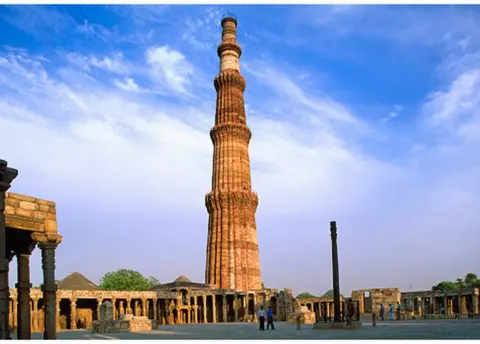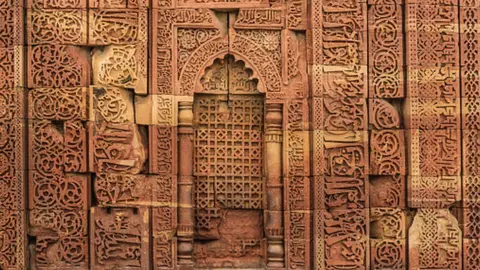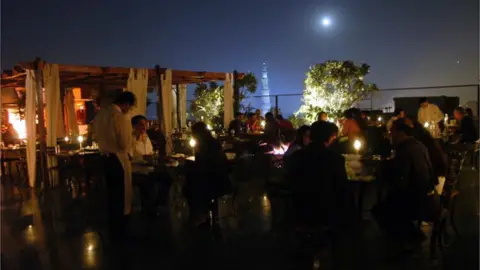Qutub Minar: Why India's tallest minaret landed in the courts
 Getty Images
Getty ImagesSoaring over the Delhi skyline - at 240 ft - the Qutub Minar is one of the capital's most iconic and stunning monuments. Now a court will decide whether temples demolished centuries ago in the complex surrounding the monument should be restored.
The World Heritage site was built as tower of victory - possibly inspired by Afghan minarets - by Qutbuddin Aibak, the first sultan of Delhi, after defeating the Hindu rulers in 1192. The red-and-buff sandstone monument contains some of the earliest structures of Muslim rule in the country. It was expanded upwards and renovated by three successors - it is now five storeys tall and 379 steps lead to the top.
Historian William Dalrymple noted that the Qutub Minar tower, which looked like a "fully extended telescope placed lens down on a plateau in [Delhi's] Aravalli hills" was a "boastful and triumphant statement of arrival".
The fortified complex housing the minaret has a chequered history. Twenty-seven Hindu and Jain temples located there were demolished and the debris was used to construct Delhi's first mosque at the site. The plinth of one of these temples was retained and expanded to accommodate the mosque, which was itself "built piecemeal", according to a 1926 note on the monument by JA Page, a senior official of the Archaeological Survey of India (ASI).
 Getty Images
Getty ImagesThere's more to the complex than the minaret. They include a 1,600-year-old 20ft-high Iron Pillar which has survived the ravages of nature and time, five arches and a tomb of one of the sultans. The buildings are decorated with Hindu and Muslim motifs. In his note, Page said the group of monuments comprised the most notable historical remains of Delhi, both in terms of "antiquity and arresting design".
More than 800 years later, courts in India are wrestling with a plea seeking the restoration of 27 temples in the complex.
In November, a civil court rejected the petition saying that India had been ruled by several dynasties and wrongs committed in the past "cannot be the basis of disturbing peace of our present and future". Now the petitioner has challenged the decision in a higher court. "When there was a temple in existence much before the mosque, why can't it be restored?" asked Hari Shankar Jain, who believes Hindu deities still exist in the complex.
Archaeologists are clear about the status of the complex, which is a protected monument under a federal law. They say its character is "irreversible and frozen". But similar disputes, backed by Hindu groups, are brewing over mosques built on demolished Hindu shrines in the cities of Varanasi and Mathura.
Muslim kings since the late 12th Century, and Hindu kings since at least the 7th Century, have looted, redefined or destroyed temples patronised by enemy kings or rebels, historians say. "Every ruler has tried to stamp his political authority and his imperial might by destroying what were the biggest religious symbols. It's not that all temples were destroyed - only the ones which had political significance," says historian Rana Safvi.
 Getty Images
Getty ImagesWhy was Qutub Minar built? Ms Safvi says one reason could be to serve as the minaret of the mosque in the complex from where the muezzin would call the faithful to prayer. Another possible reason, she says, was to use as a military watchtower to track enemy movement. However, the "most probable" reason seems that it was a victory tower, similar to minarets in Ghazni, by "which it seems to be influenced".
The sturdy tower has survived two lightning strikes - one damaged the fourth storey and the sultan replaced the original sandstone with marble and sandstone and built two additional storeys and added a cupola at the top. The cupola added 12ft to the height, but an earthquake toppled it over. (The tower survived two quakes.)
Today, the Qutub Minar is more than just a historic monument and a Delhi landmark. For one, it is embedded in the memories of long-time residents of Delhi.
Ms Safvi remembers her first visit to the minaret in 1977: "I had climbed the first storey and seen the then beautiful surrounding countryside. My elder sisters talk of an earlier visit in the 1960s when we had gone all the way to the top of the minaret." The tower, a popular excursion spot, was closed to visitors in 1981 after a stampede killed 45 people - mainly schoolchildren - on the narrow staircase.
 Getty Images
Getty ImagesThe monument is located in a gentrified neighbourhood, dotted with swish eateries and upscale boutiques. In promotions and Instagram handles, rooftop bars, lounges and restaurants with a "killer view" of the minaret are hawked as "perfect for your next date night". One eatery handle even calls the view "CrazySEXY".
All this is far removed from the turbulence over the monument in the streets and courtrooms. Earlier this month, members of a Hindu right-wing group were detained for demonstrating and chanting prayers outside the complex.
Last week, Mr Jain, the petitioner, told the court that a demolished temple "doesn't lose its character, divinity or sanctity". He said he had a constitutional right to worship at the Qutub complex.
The judge mused: "The deity is surviving for last 800 years without worship. Let it survive like that."
The verdict is due in a few weeks.
